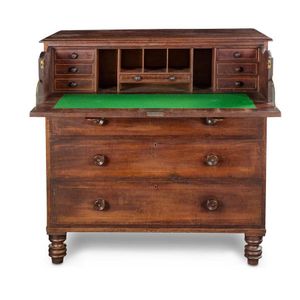Mahogany Bureau with Fitted Interior and Graduated Drawers
You must be a subscriber, and be logged in to view price and dealer details.
Subscribe Now to view actual auction price for this item
When you subscribe, you have the option of setting the currency in which to display prices to $Au, $US, $NZ or Stg.
- Bracket Feet - On bracket feet the corner edge is square and joined by a mitre to its partner on the opposite angle. The inner edge is usually shaped or scalloped. Bracket feet were first introduced in the early 18th century and used until c. 1830 and are found on carcase furniture such as chests, cabinets, bookcases and bureaux.
Ogee bracket feet, a variation on straight bracket feet, have the outside edge forming an "S" shaped curve with the top bulging outward and the bottom turning inward.
On splayed bracket feet, the exterior edge curves outward. - Fall Front - Furniture with a hinged flap, usually associated with desks and secretaires, that opens or 'falls' to provide a flat writing surface. The flap may be supported by chains or brass quadrants and rest on wooden supports or runners, known as lopers, that pull out from a recess in either side of the piece. The interior of a fall-front desk is usually fitted with small drawers and pigeonholes.
- Mahogany - Mahogany is a dense, close grained red-coloured timber from the West Indies and Central America. It was first imported into Europe in the the early 18th century and its use continued through the 19th century. It was popular for furniture making because of its strength, the wide boards available, the distinctive grain on some boards, termed flame mahogany and the rich warm colour of the timber when it was polished.. The "flame" was produced where a limb grew out from the trunk of the tree, and this timber was usually sliced into veneers for feature panels on doors, backs and cornices.
Some terms used to describe mahogany relate to the country from which it originally came, such as "Cuban" mahogany, "Honduras" mahogany etc. However unless the wood has been tested the names assigned are more a selling feature, rather than a true indication of the timber's origin. - Ogee - A serpentine shape, usually convex at the upper part, concave at the lower. Mostly used to describe the front shapes of parts of carcass furniture, such as cornices, drawer fronts and feet.
- George Iii - George III (1738 - 1820) was King of Great Britain and Ireland from 1760 to 1820.
This item has been included into following indexes:
Visually similar items

A teak military secretaire chest, the upper section with a full width drawer, the front opening to reveal pigeon holes and small drawers, above two drawers of half width, the lower section with two drawers of full width, all with recessed brass handles, br

A string inlaid cedar secretaire chest, probably Tasmanian, circa 1840, 115 cm high, 110 cm wide, 59 cm deep. Provenance: ex Clairville, Northern Tasmania. Tullochs Auctions

Unusual Georgian mahogany and ebony strung breakfront secretaire, circa 1800, recessed central cupboard, double filing drawer, baize lined radius turning drawer, with one key, gilt tooled leather inlay, ivory escutcheons, 102 cm high, 125 cm long, 61.5 cm

George IV mahogany and satinwood lined secretaire chest with ebony line inlay, circa 1830, ivory escutcheons, with key, 122 cm high, 125 cm long, 53.5 cm deep
